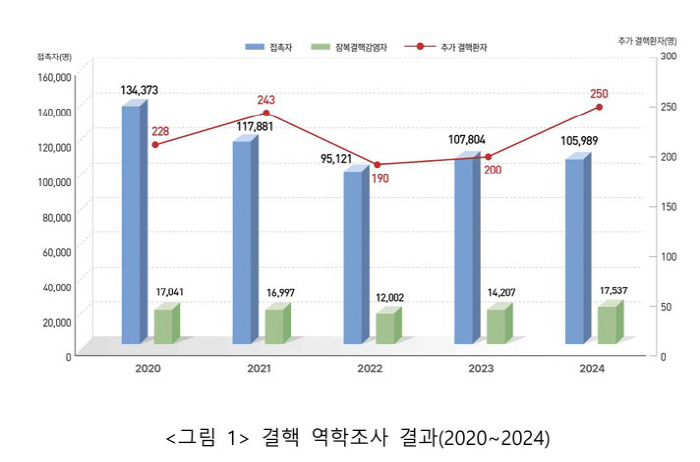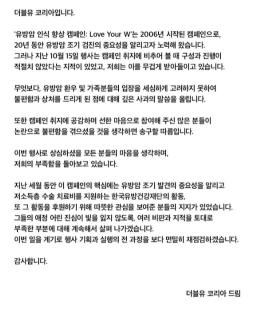250 TB patients were detected early last year...the effect of active epidemiological investigations
May 08, 2025
|
After identifying family members and contact with collective facilities who have lived in the same space for a long time with tuberculosis patients through an epidemiological investigation, tuberculosis and latent tuberculosis infection tests are conducted quickly to block transmission through immediate isolation and treatment if additional tuberculosis patients are found. In addition, it is recommended to treat latent tuberculosis infection to prevent the occurrence of tuberculosis, and to check the occurrence of tuberculosis through follow-up management.
Latent tuberculosis infection is a condition in which a small number of living bacteria exist in the body due to infection with tuberculosis bacteria, but it does not spread to others because there are no clinical symptoms of tuberculosis and the bacteria are not discharged to the outside, and it is possible to prevent tuberculosis up to 90% when treated with latent tuberculosis infection.
According to the Korea Centers for Disease Control and Prevention, there were a total of 105,989 contacts of tuberculosis patients in 2024, and as a result of the tuberculosis test, 250 additional tuberculosis patients (235.9 per 100,000 contacts) were detected early. In addition, as a result of conducting latent tuberculosis infection tests on 59,547 people in close contact, 17,537 people (29.5%) were diagnosed with latent tuberculosis infection.
The 25% (50) increase in additional tuberculosis cases detected through epidemiological investigations in 2024 compared to 2023 is the result of active additional tests, including chest CT, on latent tuberculosis infections in facilities that are feared to occur in clusters to detect tuberculosis patients early.
In addition, due to the revision of the tuberculosis treatment guidelines (5th edition) in 2024, the management has been strengthened to recommend latent tuberculosis infection testing and treatment for elderly contacts over the age of 65, who were previously limited in testing. In fact, the number of test takers for latent tuberculosis infection over the age of 65 increased by 103.2% (9060) compared to 2023, and the number of latent tuberculosis infections also increased by 101.1% (3,836).
In 2024, 18,893 family contacts of 16,220 respiratory tuberculosis patients were examined, and 108 additional tuberculosis patients (571.6 per 100,000 contacts) were found, and 4,931 latent tuberculosis infections were diagnosed, confirming that the latent tuberculosis infection rate was 30.1%. In addition, 87,096 contacts of 3,470 collective facilities were examined, and 142 additional tuberculosis patients (163 per 100,000 contacts) were found. There were 12,606 people infected with latent tuberculosis, and the latent tuberculosis infection rate was confirmed to be 29.2%.
According to the results of epidemiological surveys by group facilities, the number of surveys was the highest at 1,421 (41.0%), the incidence of additional tuberculosis patients (227.9 per 100,000 contacts) and latent tuberculosis infection (37.9%) in social welfare facilities, and most of the epidemiological surveys in social welfare facilities were targeted at elderly care facilities. The higher incidence of tuberculosis among contacts of social welfare facilities than the incidence of tuberculosis among the elderly aged 65 or older (105.8 per 100,000 people) is interpreted as the effect of long-term close contact with tuberculosis patients.
Ji Young-mi, Director of the Korea Centers for Disease Control and Prevention, asked "Contactors of tuberculosis patients have about seven times higher risk of developing tuberculosis than the general population, so it is very important to actively participate in epidemiological investigations." Among the contacts of infectious tuberculosis patients, those who have been identified as latent tuberculosis infection are high-risk groups for developing tuberculosis, and completion of latent tuberculosis infection treatment can prevent up to 90% of tuberculosis."," he said.
Meanwhile, according to the report status of tuberculosis patients in 2024 announced by the Korea Centers for Disease Control and Prevention on March 24th '15th TB Prevention Day', the number of tuberculosis patients in Korea has decreased for 13 consecutive years and has decreased by 7.6% annually. After reaching a peak of 50,491 in 2011, it fell 64.5% until last year. Last year, 17,944 tuberculosis patients occurred in Korea, down 8.2% from 2023.
This article was translated by Naver AI translator.














